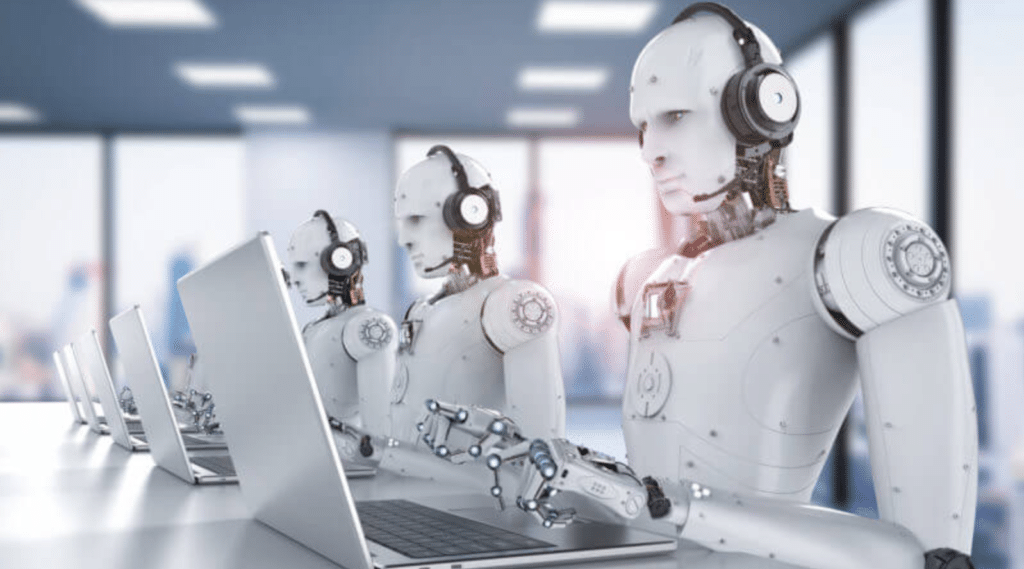Table of Contents
Introduction
In the modern business world, innovation and efficiency are paramount. As companies seek ways to streamline operations and maximize profits, the integration of technology into everyday tasks has become inevitable. Enter Business Process Automation with AI—a groundbreaking approach that’s redefining the contours of business operations.
Business Process Automation (BPA) is no newcomer to the corporate lexicon. For decades, industries have sought ways to automate repetitive tasks, reduce human error, and enhance efficiency. However, the introduction of Artificial Intelligence (AI) into this domain has elevated BPA to an entirely new level. With Business Process Automation with AI, tasks are not just automated; they’re optimized, predicted, and continuously improved upon.
From customer service chatbots that can resolve queries round the clock, to predictive analytics that forecast market trends, AI-driven automation is the linchpin in this new era of business. This article delves deep into the transformative journey of Business Process Automation with AI, its implications, challenges, and the immense potential it holds for the future.
1. The Evolution of Business Process Automation with AI
The trajectory of Business Process Automation with AI mirrors the rapid advancements in the tech world. From rudimentary software solutions to the incorporation of complex AI algorithms, the landscape of business automation has been continually evolving. This section traces the origins and growth of AI in business processes.
The Early Days of Business Process Automation with AI
Before AI became a household term, businesses were already delving into ways to automate their operations. The initial stage, however, was less about artificial intelligence and more about scripting and rule-based solutions.
Basic automations and decision trees In the infancy of business automation, tasks were automated using basic scripts and decision trees. For instance, an IT system might be programmed to process orders at a certain time of day or a banking software might be set to flag transactions above a specific amount for review. These systems followed strict rule-based protocols, lacking the ability to learn or adapt.
Limitations and challenges While these early methods streamlined operations to an extent, they came with inherent limitations. First and foremost, the static nature of these automations meant they couldn’t adjust to new or unforeseen situations. This rigidity often led to inefficiencies or errors when met with out-of-the-ordinary scenarios. Moreover, maintaining and updating such systems was labor-intensive, often requiring a complete overhaul to integrate new rules or processes. The real game-changer came with the introduction of AI into this realm, transforming the very essence of Business Process Automation with AI.
Modern AI Innovations and Their Impact on Business Process Automation with AI
As technology evolved, the realm of automation experienced transformative innovations. No longer confined to static, rule-based operations, the integration of advanced AI technologies like machine learning and deep learning redefined Business Process Automation with AI.
Machine Learning and Deep Learning Applications Machine learning (ML) gave systems the ability to ‘learn’ from data. Instead of just executing predefined rules, ML algorithms process vast amounts of information, identify patterns, and adjust their operations based on these patterns. This adaptive nature allowed for greater accuracy and efficiency in automating complex tasks.
Deep learning, a subset of machine learning, takes this a step further. Utilizing neural networks inspired by the human brain, deep learning models can process even more intricate patterns in massive datasets. Such capabilities have made it possible to automate tasks that were once deemed too complex, like image and speech recognition.
Real-world Business Use-cases: Customer Service, Marketing, Finance, etc. The practical applications of Business Process Automation with AI in contemporary industries are profound:
- Customer Service: Chatbots powered by AI can handle a plethora of customer queries, often without any human intervention. They can learn from customer interactions, making them more efficient over time.
- Marketing: AI-driven analytics tools can predict market trends, allowing companies to tailor their strategies for maximum impact. Content personalization, customer segmentation, and predictive advertising are just a few examples.
- Finance: Automated fraud detection systems can scan millions of transactions in real-time, flagging suspicious activities with remarkable accuracy. Moreover, robo-advisors are reshaping the investment landscape, offering personalized financial advice based on AI-driven analyses.
These are just a few glimpses into a world revolutionized by Business Process Automation with AI. With every passing day, new applications emerge, making businesses more agile, responsive, and efficient.
Business Process Automation with AI: Future Outlook of Business Process Automation with AI
As we stand on the cusp of a new era in technological advancements, the horizons for Business Process Automation with AI continue to expand. The convergence of AI with other breakthrough technologies and the lessons learned from its current applications are shaping an intriguing future. Let’s explore the potential trajectories and the ethical landscape that awaits.
Predictions for the Next Decade The next decade promises to be transformative for Business Process Automation with AI. Here are some prognostications:
- Interconnectivity with IoT: As the Internet of Things (IoT) proliferates, AI-driven automation will manage and analyze data from billions of connected devices in real-time, optimizing everything from industrial operations to urban planning.
- Quantum Computing: The emergence of quantum computing could supercharge AI algorithms, making automations even more efficient and capable of tackling problems currently deemed unsolvable.
- Personalized User Experiences: Businesses will harness AI to craft hyper-personalized user experiences, automating interactions based on individual preferences, histories, and behaviors.
- Decentralized AI: With advancements in blockchain and decentralized technologies, we may see AI models that run on decentralized networks, ensuring more transparency and control over automated processes.
Ethical Considerations and Challenges Ahead With great power comes great responsibility. As Business Process Automation with AI delves deeper into our lives and industries, a slew of ethical dilemmas surface:
- Bias and Fairness: AI models are only as unbiased as the data they’re trained on. Ensuring fairness and avoiding automation that perpetuates societal biases is paramount.
- Job Displacements: While automation streamlines operations, there’s a tangible fear of job losses. Businesses and societies must find a balance, possibly through reskilling initiatives and education reforms.
- Privacy Concerns: Automated systems that collect and process vast amounts of data pose significant privacy risks. Striking a balance between efficiency and privacy is a challenge that will persist.
- Transparency and Accountability: As AI systems become more complex, ensuring their decisions are transparent and holding them accountable becomes crucial.
The journey of Business Process Automation with AI is one of promise and caution. As we steer into the future, a judicious blend of innovation and ethics will dictate the path ahead.
2. Thematic Exploration of AI’s Business Impact
Operational Efficiency
At the heart of successful business strategies lies the drive for optimal operational efficiency. This underpins faster deliveries, better product and service quality, and improved profit margins. The evolution of Business Process Automation with AI plays a pivotal role in amplifying these efficiencies, heralding a new era of business operations.
Automation of Repetitive Tasks Before the fusion of AI with business automation, mundane, repetitive tasks were often labor-intensive, time-consuming, and prone to human error. With AI in the picture, processes like data entry, invoicing, and even preliminary customer interactions have been automated. This doesn’t just result in time and cost savings; it also ensures a high level of accuracy. Furthermore, by freeing human workers from these tasks, it allows them to focus on more value-added activities, fostering innovation and creativity within the business environment.
Real-time Data Analytics and Insights In the information age, data is the new gold. However, raw data, without timely processing and analysis, can often be overwhelming. Here, Business Process Automation with AI shines brightly. AI algorithms can sift through vast amounts of data in real-time, extracting actionable insights. Whether it’s identifying emerging market trends, monitoring equipment performance in real-time to predict failures, or offering instantaneous personalized product recommendations to online shoppers, the power of real-time AI-driven analytics is revolutionizing business decision-making.
3. Business Process Automation with AI: Enhancing Customer Experiences
The modern customer is more informed, discerning, and expects a seamless experience. Through Business Process Automation with AI, companies are not only meeting these expectations but exceeding them, setting new benchmarks in customer service and engagement.
Chatbots and 24/7 Support In an age of instant gratification, the demand for round-the-clock support is palpable. Enter chatbots – AI-powered virtual assistants that cater to customer queries, complaints, or any assistance, irrespective of the time zone or hour. Not only do these chatbots provide immediate responses, but they also learn from every interaction, ensuring that their solutions become increasingly effective and personalized over time.
Personalized Marketing and Recommendations The era of generic marketing is waning. Today, customers crave personalization – messages, products, and experiences tailored specifically for them. Leveraging AI, businesses can analyze individual browsing patterns, purchase histories, and even social media activity to craft hyper-personalized marketing campaigns. This leads to higher engagement rates, improved customer loyalty, and enhanced sales.
AI in E-commerce and Virtual Try-ons The e-commerce sector is witnessing an AI-led metamorphosis. Beyond just recommending products, AI now offers virtual try-ons, allowing customers to visualize how a particular product, be it clothing or furniture, might look on them or in their space. This immersive experience, powered by augmented reality and AI, significantly reduces return rates and boosts customer satisfaction.
Decision-Making and Strategy
Decision-making in the business realm is a delicate balance between intuition and data. With the integration of Business Process Automation with AI, data-driven decision-making is not only accurate but also prescient.
Predictive Analytics and Forecasting Anticipating market trends, customer preferences, or potential supply chain disruptions is invaluable for businesses. Through predictive analytics powered by AI, companies can analyze past data and current market conditions to forecast future scenarios. This foresight enables businesses to be proactive, capitalizing on opportunities and mitigating challenges.
Risk Assessment and Management Risk is an inherent part of business operations, but AI offers tools to quantify, categorize, and manage these risks. From credit risk in banking to operational risks in manufacturing, AI algorithms can analyze multifaceted data sources to provide a comprehensive risk assessment, allowing businesses to take informed measures.
AI in Mergers and Acquisitions Mergers and Acquisitions (M&As) are complex endeavors, often involving the analysis of vast amounts of data to gauge viability. AI can streamline this process by rapidly analyzing financial statements, market positions, and even cultural compatibility factors. This not only speeds up the M&A process but also increases the likelihood of successful integrations.
4. Potential Roadblocks and the Path Forward
As with any groundbreaking technology, the integration of AI into business processes is not without its challenges. While its capabilities are revolutionary, there are roadblocks, particularly in the regulatory realm, that businesses must contend with. Understanding these challenges and charting a forward path is essential for sustainable AI adoption.
Regulatory Challenges
The rapid ascent of AI and its profound implications has led to a scramble among governments and international bodies to draft regulations ensuring its safe and ethical use. For businesses, these regulations can often seem like a constantly shifting maze.
Balancing Innovation with Governance There’s an inherent tension between innovation and regulation. On one hand, businesses strive to push the boundaries of what AI can achieve, seeking to derive maximum benefits. On the other, they must operate within regulatory confines designed to ensure ethical and safe AI deployment. Striking a balance is challenging. Too much regulation might stifle innovation, while lax governance could lead to ethical lapses or public backlash. Businesses must engage in continuous dialogue with regulators, ethicists, and the public to ensure that innovation thrives while adhering to ethical and legal standards.
Skills and Talent Gap
The advent of Business Process Automation with AI heralds an era of immense potential, but it also surfaces a pressing concern – the gap between the skills businesses need and the current capabilities of the workforce. Addressing this gap is imperative to fully leverage the benefits of AI.
The Need for AI Education and Training While AI systems can automate various tasks, their deployment, maintenance, and optimization require human oversight. The present-day workforce, primarily trained in traditional disciplines, often lacks the requisite knowledge to handle these advanced systems. Companies must invest in upskilling their employees, collaborating with educational institutions, and even fostering in-house training programs. This not only ensures smooth AI adoption but also safeguards employees against job redundancy.
Bridging the Divide Between Tech and Traditional Business Roles The integration of AI in business blurs the lines between tech-centric roles and traditional business positions. It’s no longer sufficient for marketers, HR professionals, or finance experts to operate without a basic understanding of AI and its implications. Cross-disciplinary training programs, encouraging tech and non-tech teams to collaborate, and creating roles like ‘business technologists’ can help bridge this divide.
Integration and Scalability
Adopting AI is not a mere switch from manual to automated processes. It’s a complex transformation that requires careful planning, especially regarding system integration and future scalability.
Ensuring AI Systems Can Grow with Business Needs AI isn’t a one-size-fits-all solution. As businesses evolve, their AI needs and applications will also change. Scalability, therefore, is a crucial consideration. Solutions adopted should be modular and adaptable, allowing for enhancements without necessitating complete overhauls. Businesses must also ensure that their AI vendors or in-house teams prioritize scalability, preparing the company for future growth trajectories and changing market dynamics.
Conclusion
The journey of Business Process Automation with AI is not a straightforward path but rather a tapestry of opportunities, challenges, and transformative moments. As AI technologies continue to advance, they promise unprecedented efficiencies, innovative customer experiences, and strategic insights that can catapult businesses to new heights. Yet, the road is dotted with regulatory, talent, and integration challenges that require careful navigation.
It’s imperative for businesses to approach AI not just as a tool, but as an evolving partner – one that necessitates investment in education, cross-disciplinary collaboration, and a forward-thinking approach. By embracing both the immense potential and the inherent challenges of AI, businesses can forge a future that’s not only technologically advanced but also sustainable, ethical, and truly revolutionary.
For a deeper dive into the intricacies of AI and its evolving role in business, consider exploring the comprehensive Wikipedia article on Artificial Intelligence.







